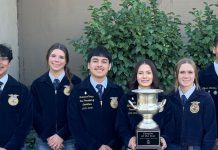The San Andreas and Central Calaveras faults sandwich the city.
Miles of railroad run through the town center.
Gilroy – The San Andreas and Central Calaveras faults sandwich the city. Miles of railroad run through the town center. The threat of wildfires in the hills surrounding the city is real. Gilroy is home to more than 47,000 people and has a history of environmental disasters including the floods of 1986 and the Loma Prieta earthquake in 1989.
With the 16th anniversary of the Loma Prieta earthquake this month and the images of the Oct. 8 earthquake in Pakistan fresh in people’s minds, residents may wonder what city and emergency crews are doing to prepare for a catastrophic emergency? And more importantly – are we ready?
“It is truly Murphy’s Law during a disaster,” said City Administrator Jay Baksa. “Since (1986), we have spent a lot of time making sure our staff members and everyone in our organization is trained to do what they’re supposed to do.”
Every month, members of Gilroy’s Emergency Operations Center meet to review and update its response plans. Members run simulated emergency responses several times each year tweaking methods to save precious seconds of the response crews.
The group consists of city officials and employees from across Gilroy and covers five areas including operations, logistics, planning/intelligence, management, and finance. For precautionary reasons, lines of succession run four people deep for each division head.
Gilroy’s EOC has been fully activated three times in the past 20 years: Once for the 1986 floods, the second time for the Loma Prieta earthquake and the last in Jan. 1998 for a potential flood. In Sept. 2002, a portion of the EOC was activated in support of the California Division of Forestry during the Croy Road fire.
Baksa is head of the EOC and has witnessed it evolve over the years.
“In the last 20 years there has been a much higher emphasis on training,” he said. “California is fortunate in a sense because we get a lot of practice at this stuff.”
Emergency EOC simulations have included everything from earthquakes and floods to hazardous material spills.
The events of Sept. 11 brought terrorism to the forefront. While city officials consider a terrorist act unlikely in Gilroy, they have prepared for such a scenario in San Jose or San Francisco that would bring evacuees southbound.
“We have to play the odds,” Baksa said. “I think we’ve touched on everything in all the years that I’ve been here.”
After the 1986 floods, Gilroy officials realized they needed to revisit emergency plans.
“We found we had a system here, but the system wasn’t good,” Baksa said. “Everybody knew their role but it wasn’t detailed enough. There wasn’t enough knowledge about this type of disaster. You always get a lot of knowledge after a disaster hits … That took us to (emergency plans) becoming a number one priority in the city, and it still is.”
In the mid-1990s Gilroy’s EOC adopted the Standardized Emergency Management Systems, a statewide incident command system based off of military models of operation. They communicate with the county and state level EOC groups regularly to stay informed of any changes.
After the recent hurricanes in the Gulf Coast, Gilroy’s EOC members are examining their own response plans.
“With Katrina and Rita you saw who was really prepared and who wasn’t,” Baksa said.
But preparedness is not only important for the city’s EOC members.
Preparation is Key
Businesses, schools and community members are advised to be prepared for worst-case scenarios and be equipped with evacuation plans.
“The government can’t be everywhere in a major catastrophe. What you have to rely on is the people – (they) have to be prepared,” Baksa said. “Our message to everyone is, if we had a major catastrophe and this town was leveled … You need to have the capabilities to handle things on your own.”
With the city equipped with 10 on duty firefighters at one time, response will be severely delayed during a catastrophic emergency.
The federal government recommends individuals be prepared for at least 72 hours on their own.
“We would like people to be as self-sufficient as possible,” said Joe Kline, who serves as the EOC’s public information officer. “It’s important for people to have safety plans in place, meeting places, contact numbers … so everybody can be accounted for.”
The key to remaining calm in an emergency is preparation beforehand, Kline said.
Nonperishable food, water, medication, personal toiletries, a battery operated AM radio should be staples at one’s home.
“(Preparedness), is one of those things that everybody has good intentions to do,” Kline said. “You’re never going to be 100 percent prepared because every disaster is different. The key is being as prepared as possible.”
According to Mary Saccullo, owner of Saccullo’s Discount Surplus, the store has experienced a surge in business for the past month.
Portable toilets, camper showers, nonperishable foods, and containers for emergency supplies have been the most popular lately, she said.
“Think camping,” she said. “Everyone should have a propane operated outside stove so you can at least boil water and cook if you have to.”
Toilet paper, can openers, and items for personal hygiene are vital as well, she said.
After disasters occur across the country, people become reminded of what could happen, Saccullo explained.
“When we got ready for the millennium we were nonstop. After 9/11 the phone was off the hook,” she said. “It’s emergencies that get people thinking.”













